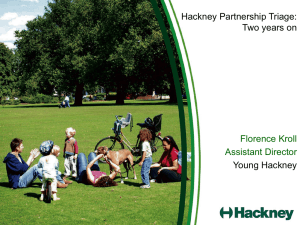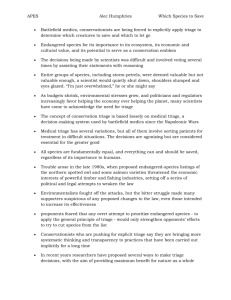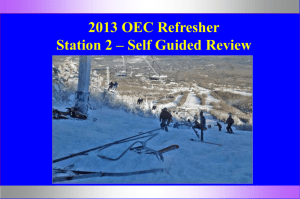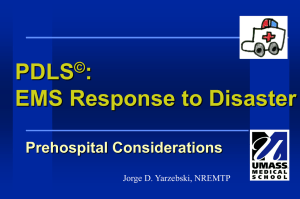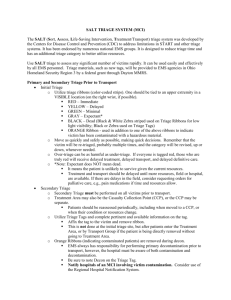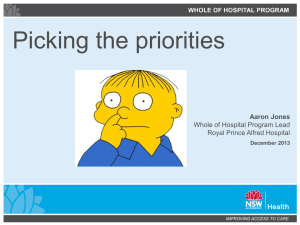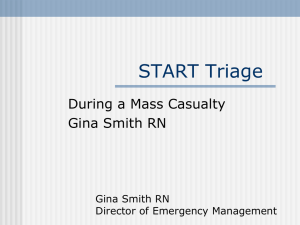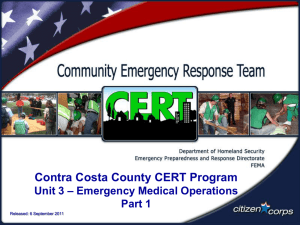Triage
advertisement
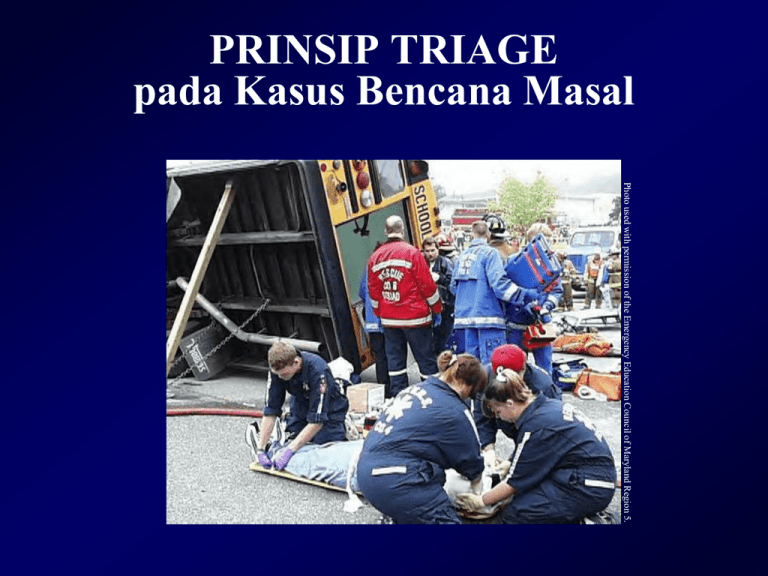
PRINSIP TRIAGE pada Kasus Bencana Masal Photo used with permission of the Emergency Education Council of Maryland Region 5. What is Triage? “Triage” sortir Evaluasi berdasarkan kebutuhan medis dan urgensi pada masing2 klien dalam waktu terbatas Triage is a dynamic process and is usually done more than once. Primary Disaster Triage Triage based on physiology Kemampuan pasien dalam menghadapi /mengkompensasi trauma atau injuri Bila gagal prioritas tinggi Primary Disaster Triage The most commonly used adult tool in the US and Canada is the START tool. The pediatric MCI primary triage tool most commonly used in the US and Canada is Jump START. The Best Tool? No MCI primary triage tool has been validated by outcome data. Wiseman DB, Ellenbogen R, Shaffrey CI. “Triage for the Neurosurgeon”, Neurosurg Focus 12(3), 2002. Available on the Internet at www.medscape.com/viewarticle/431314 Triage Categories NATO Guidelines Red Airway obstruction, cardiorespiratory failure, significant external hemorrhage, shock, sucking chest wound, burns of face or neck Yellow Open thoracic wound, penetrating abdominal wound, severe eye injury, avascular limb, fractures, significant burns other than face, neck or perineum NATO Guidelines Green Minor lacerations, contusions, sprains, superficial burns, partial-thickness burns of < 20% BSA Black Head injury with GCS<8, burns >85% BSA, multisystem trauma, signs of impending death START: Step 1 Triage officer announces that all patients that can walk should get up and walk to a designated area for eventual secondary triage. All ambulatory patients are initially tagged as Green. START: Step 2 Triage officer assesses patients in the order in which they are encountered Assess for presence or absence of spontaneous respirations If breathing, move to Step 3 If apneic, open airway If patient remains apneic, tag as Black If patient starts breathing, tag as Red START: Step 3 Assess respiratory rate If ≤30, proceed to Step 4 If 30, tag patient as Red START: Step 4 Assess capillary refill If ≤ 2 seconds, move to Step 5 If 2 seconds, tag as Red START: Step 5 Assess mental status If able to obey commands, tag as Yellow If unable to obey commands, tag as Red Mnemonic R P M 30 2 Can do Photo used with permission of the Emergency Education Council of Maryland Region 5. What’s your call? An adult kneels at the side of the road, shaking his head. He says he’s too dizzy to walk. RR 20 CR 2 sec Obeys commands What’s your call? Adult female driver still in the bus, trapped by her lower legs under cavedin dash. RR 24 Cap refill 4 sec Moans with verbal stimulus What’s your call? An adult male lies inside the bus. Apneic Remains apneic with jaw thrust What’s your call? An adult male lies on the ground RR 20 Good distal pulse Obeys commands but cries that he can’t move his legs OR Key Points about MCI Triage MCI triage will never be logistically, intellectually, or emotionally easy… FEMA Photo Library but we must be prepared to do it using the best of our knowledge and abilities. Key Points The physiology of adults and children differ; therefore different primary triage systems should be used Use JumpSTART for infants through older children Use START for young adults and older Primary triage is just the first look at an MCI victim, similar to the primary/initial survey/assessment

